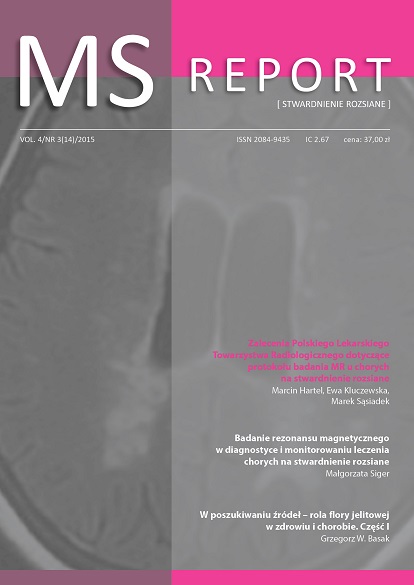Badanie rezonansu magnetycznego w diagnostyce i monitorowaniu leczenia chorych na stwardnienie rozsiane Artykuł przeglądowy
##plugins.themes.bootstrap3.article.main##
Abstrakt
Rezonans magnetyczny od wielu lat stanowi podstawowe badanie dodatkowe wykorzystywane w diagnostyce i monitorowaniu leczenia chorych na stwardnienie rozsiane (MS, multiple sclerosis). Modyfikowane wielokrotnie kryteria rozpoznawania MS pozwalają na postawienie diagnozy w bardzo wczesnej fazie choroby i rozpoczęcie terapii w jej początkowej fazie. Analiza różnych parametrów rezonansowych umożliwia pełniejszą ocenę efektywności terapii stosowanych zarówno w badaniach klinicznych, jak i w programie leczenia chorych na MS refundowanym przez Narodowy Fundusz Zdrowia. Prezentowany artykuł omawia zasady diagnostyki rezonansowej, podstawowej diagnostyki różnicowej oraz sposoby monitorowania skuteczności leczenia u chorych ze stwardnieniem rozsianym.
##plugins.themes.bootstrap3.article.details##
Copyright © by Medical Education. All rights reserved.
Bibliografia
2. Rovira A., Auger C., Alonso J.: Magnetic resonance monitoring of lesion evolution in multiple sclerosis. Therapeutic Advances in Neurological Disorders 2013; 6: 298-310.
3. He J., Grossman R.I., Ge Y. et al.: Enhancing patterns in multiple sclerosis: evolution and persistence. Am. J. Neuroradiol. 2001; 22: 664-669.
4. Barkhof F., Hommes O.R., Scheltens P. et al.: Quantitative MR changes in gadolinium-DTPA enhancement after high-dose intravenous methylprednisolone in multiple sclerosis. Neurology 1991; 41: 1219-1222.
5. McDonald W.I., Compston A., Edan G. et al.: Recommended diagnostic criteria for multiple sclerosis: guidelines from International Panel on the Diagnosis of Multiple Sclerosis. Ann. Neurol. 2001; 50: 121-127.
6. Tintore M., Rovira M., Francis G. et al.: New diagnostic criteria for multiple sclerosis. Application in the first demyelinating episode. Neurology 2003; 60: 27-30.
7. Swanton J.K., Rovira A., Tintore M. et al.: MR criteria for multiple sclerosis in patients with clinically isolated syndrome: a multicentre retrospective study. Lancet Neurol. 2007; 6: 677-686.
8. Polman C.H., Reingold S.C., Edan G. et al.: Diagnostic criteria for multiple sclerosis: 2005 revision to the “McDonald criteria”. Ann. Neurol. 2005; 58: 840-846.
9. Agarval R., Sze G.: Neuro-Lyme disease: MR imaging findings. Radiology 2009; 253: 167-173.
10. Bester M., Petracca M., Inglese M.: Neuroimaging of multiple sclerosis, acute disseminated encephalomyelitis and other demyelinating disease. Seminars in Roentgenology 2014; 49: 76-85.
11. Wingerchuk D.M., Banwell B., Bennett J.L. et al.: International consensus diagnostic criteria for neuromyelitis optica spectrum disorders. Neurology 2015; 85: 177-189.
12. Kim H., Friedmann P., Lana-Peixoto M. et al.: MR characteristic of neuromyelitis optica spectrum disorder: An international update. Neurology 2015; 84: 1165-1173.
13. Anderson V.M., Fox N.C., Miller D.H. et al.: Magnetic resonance imaging measures of brain atrophy in multiple sclerosis. J. Magn. Reson. Imaging 2006; 23: 605-618.
14. Sacco R., Bisecco A., Corbo D. et al.: Cognitive impairment and memory disorders in relapsing-remitting multiple sclerosis: the role of white matter, gray matter and hippocampus. J. Neurol. 2015; 262: 1691-1697.
15. Sormani M.P., Arnold D.L., De Stefano N.: Treatment on brain atrophy correlates with treatment effect on disability in multiple sclerosis. Ann. Neurol. 2014; 75: 43-49.
16. Stangel M., Penner I.K., Kallmann B.A. et al.: Towards the implementation of‘no evidence of disease activity’ in multiple sclerosis treatment: the multiple sclerosis decision model. Ther. Adv. Neurol. Disord. 2015; 8: 3-13.
17. Simon J.H., Li D., Traboulsee A. et al.: Standardized MR imaging protocol for multiple sclerosis: Consortium of MS centers consensus guidelines. Am. J. Neuroradiol. 2006; 27: 445-461.

